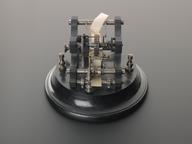

Coherer, one of two, designed and used by Edouard Branly, unsigned, Europe, 1885-1940 (Part of Branly collection? A182822, B3875)
Coherers designed and used by Edouard Branly, unknown maker, 1885-1940.
The coherer was the first practical device for detecting Hertzian waves. It was devised by French physicist Edouard Branly in about 1890 who did not, however, investigate its use for detecting Hertzian waves. Its most familiar form was a tube containing metal filings or turnings loosely packed between metal plugs. This presented a high resistance to current but changed to low resistance in the presence of electric waves because the filings 'cohered' or stuck together. In order to restore the high-resistance state the tube needed to be given a mechanical tap or jolt. This coherer came from a collection of apparatus associated with Branly, but it is not known if it dates from before or after 1894.
Details
- Category:
- Telecommunications
- Collection:
- Sir Henry Wellcome's Museum Collection
- Object Number:
- 2015-541
- Materials:
- metal (unknown), copper (alloy), glass and paper (fibre product)
- Measurements:
-
overall: Length = 152mm, Diameter = 11mm., Weight = 0.062Kg
- type:
- coherer
- credit:
- On loan from Wellcome Trust




